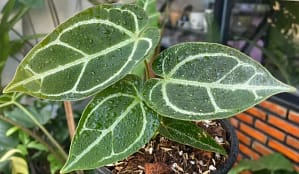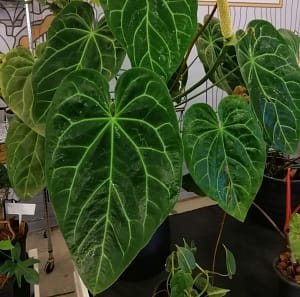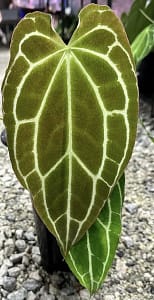Anthurium crystallinum, also known as the Laceleaf, is a beautiful and exotic plant that is incredibly rare. It originates from Central and South America, where you can find them thriving in the humid regions of the rainforest floor.
This stunning perennial has large, waxy, green tropical foliage with thick, shining veins, which can become slightly mottled with yellow in bright light. It is an epiphyte, meaning that it won’t harm the trees or the environment in the rainforest and can survive amongst moss without needing soil. Because of this, these plants are sought after by many and are becoming increasingly hard to get hold of.
Care for your Laceleaf is relatively simple as long as you understand the rainforest environment they thrive in.

Tips for nurturing your Anthurium crystallinum
Light
These plants will do best in areas of medium to bright indirect light, and bright, direct light in the early morning or late afternoon. Try to avoid direct sunlight at all times because this could possibly scorch the foliage.
Temperature
They prefer temperatures between 16˚C and 25˚C (60-77°F), so keep them inside your home where it’s nice and warm.
Soil Type & Drainage
Your Laceleaf will need a well-draining soil or potting mix, such as one made for orchids. This helps it to get enough oxygen and prevent root rot.
Humidity
These plants love high levels of humidity and will benefit from occasional misting and from being placed on a humidity tray. You can do this by placing a layer of pebbles or shells in a shallow dish of water next to the plant and then the pot on top. This will keep the air around the plant moist.
Watering
Water your Laceleaf about once a week and make sure the soil is moist but not saturated. If possible, water in the morning with filtered lukewarm water.
Toxicity
Keep in mind that this plant is toxic to humans and animals if ingested, so it may not be the best choice for households with curious animals or small children.
Fertiliser
You should fertilise the plant once a month during the growing season (spring to fall) with a balanced fertiliser to help the plant thrive.

Troubleshooting Pests, Diseases and Common Problems
The most common problem with Laceleaf is root rot, which is caused by overwatering. To prevent this, make sure you always use well-draining soil and wait until the top of the soil has dried out before you water it again. Scale insects or mites can occasionally infest the leaves and should be removed as soon as possible.
Propagation
Anthurium crystallinum can be propagated by division. Wait until the roots are actively growing and then carefully divide the plant into two or more sections, making sure to keep each section with an equal amount of roots. Plant it in a new pot with plenty of well-draining soil and keep it in a warm part of your home with high humidity

Final Thoughts
The Anthurium crystallinum is truly a mesmerising plant. It is hard to come by so if you do find one, make sure you take extra special care of it! With the right love and care you’ll have a stunning and unique little rainforest in your home that everyone will admire.
